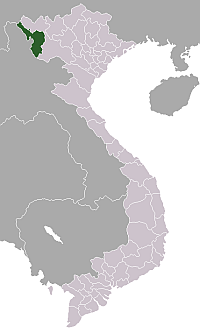|
Operation Castor
 Operation Castor[a] was a French airborne operation in the First Indochina War. The operation established a fortified airhead in Điện Biên Province, in the north-west corner of Vietnam and was commanded by Brigadier General Jean Gilles. The Operation began at 10:35 on 20 November 1953, with reinforcements dropped over the following two days. With all its objectives achieved, the operation ended on 22 November. Castor was the largest airborne operation since World War II. ExecutionThe French paratroopers of the 6ème Bataillon de Parachutistes Coloniaux (6 BPC) and the 2nd Battalion of the 1er Régiment de Chasseurs Parachutistes (II/1er RCP) dropped over Dien Bien Phu on the first day in order to secure the airstrip built by the Japanese during the occupation of French Indochina by Japan from 1940 to 1945. The operation took 65 of the 70 operational C-47 Dakota and all 12 C-119 Flying Boxcar transport aircraft the French had in the area, and still required two trips to get the lead elements into the valley. Also dropped in the first wave were elements of the 17e Régiment de Génie Parachutiste (RGP) ("17th Airborne Engineers Regiment") and the Headquarters group of Groupement Aéroporté 1 (GAP 1), ("Airborne Group 1"). They were followed later in the afternoon by the 1er Bataillon de Parachutistes Coloniaux (1 BPC) and elements of 35e Régiment d'Artillerie Légère Parachutiste (35 RALP) and other combat support elements. Just after its landing, the 6 BPC ran into contact with the Việt Minh 910th Battalion, 148th Regiment, which was conducting field exercise in the area along with a battery from the 351st Artillery Division and an infantry company of the 320th Division. Fighting persisted until afternoon when the Việt Minh units eventually withdrew to the south. The following day, the second airborne group, "GAP 2" – consisting of 1er Bataillon Etranger de Parachutistes (1 BEP), 8e Bataillon de Parachutistes de Choc (8 BPC), other combat support elements and the entire command and Headquarters group for the Dien Bien Phu operation under Brigadier General Jean Gilles – was dropped in. While on another drop zone, the heavy equipment came down and the engineers quickly set about repairing and lengthening the airstrip. On 22 November, the last troops of the initial garrison, the 5e Bataillon de Parachutistes Vietnamiens ("Battalion of Vietnamese Parachutists", 5 BPVN), jumped into the valley. In the same "stick" as the commander of 5 BPVN was Brigitte Friang, a woman war correspondent with a military parachutist diploma, and five combat jumps.[5] These troops raised the Dien Bien Phu garrison to its full planned strength of 4,500. On November 30, orders were issued for the garrison to guarantee free use of the airfield, to hold the position to the last man, and to conduct attacks to retard buildups of Viet Minh forces.[6] General Navarre created the outpost to draw the Việt Minh into fighting a pitched battle. That battle, the Battle of Dien Bien Phu, occurred four months after Operation Castor. French order of battleAeroportable Division Element (French: , Elément Divisionnaire Aéroporté, EDAP):
ReferencesNotes
Sources
External links
|
||||||||||||||||||||||||||||||
